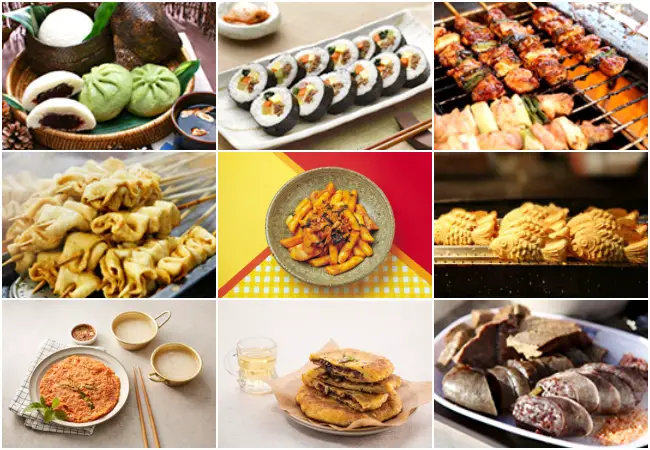We’ve had a hefty exposure to Korean snacks by watching K-Dramas.
From gimbap, tteokbokki, sundae and hotteok; I’m sure those mouthwatering Korean food might have hit your area.
But if you will have a trip to Korea soon, include it on your bucket list to experience these Korean snacks while going on a walking tour.
Street food stalls selling these Korean snacks abound in Korea, so make sure you have a go for it.
TIP: You can head to Gwangjang and Tongin markets to get all these sumptuous street food in one go.
If you are a foodie, why not make an itinerary where you will try popular Korean snacks in one day?
Visit Korea got you covered on what you should try first.
Gimbap
A complete meal to eat when you are in a hurry, kimbap is filling and will let you last before your proper meal when you are traveling. The ingredients include rice, seasonings, eggs, eomuk, carrot, seasoned spinach and pickled radish. Depending on the ingredients, the taste varies.
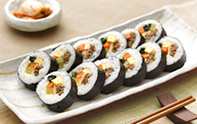
Buchimgae/Jeon
Often, we see it as a side dish on those table spreads featured in K-Dramas. Known as Korean pancakes, it mixes meat, seafood, vegetables and eggs with flour batter and then pan-fried with oil. Each jeon gets its name from the main ingredient used, such as pajeon (green onion pancake) and kimchi jeon (kimchi pancake).

Tteokbokki
A popular comfort food, tteokbokki gets a perennial mention in Korean dramas. It is one of the most common food items sold by street vendors. Cylinder-shaped rice cakes with eomuk and vegetables are cooked in a spicy yet sweet red pepper sauce. Various fusion tteokbokki is also available to suit different tastes of people.
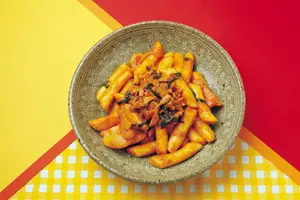
Sundae
Sundae is a traditional sausage made of the lining of pig intestines stuffed with a mixture of bean curd, vegetables and glass noodles. It is usually dipped in seasoned salt and in some regions, it is served with ssamjang, a mixed paste of gochujang and doenjang (fermented soybean paste).
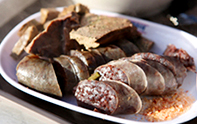
Twigim
Twigim is the general term for deep-fried food covered with a batter of flour and eggs. Squid, dumplings, potatoes, shrimp and assorted vegetables are the usual main ingredients. They taste even better dipped in soy sauce or tteokbokki sauce.

Eomuk
Eomuk’s main ingredient consists of ground fish meat. It is usually skewered and boiled in radish and green onion broth. Eomuk is especially popular as a winter snack.
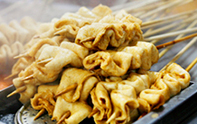
Kkochi
Kkochi refers to cooking skewers of meat. The most common kkochi is dak kkochi, or chicken skewers. Small pieces of chicken and vegetables are skewered, coated in sauce, and then grilled. Sausages, fish cakes and tteokgalbi (grilled short rib patties) are also often skewered, adding fun to choosing your own favorite kkochi.
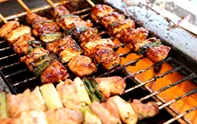
Hotteok
Hotteok is a chewy pancake, usually stuffed with various combinations of sugar and walnuts or pine nuts. A popular street food mostly found in winter, some hotteok are stuffed with vegetables or cheese instead.

Bungeo ppang
Bungeo ppang, a favorite winter snack, gets its name from its fish-like shape. This sweet snack is molded in the shape of a carp, called bungeo in Korean. The pancake batter-like shell is filled with red-bean paste, cream, or cheese and then baked.
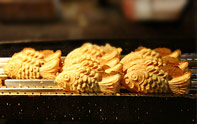
Hoppang
Hoppang is one of the most popular warm snacks in winter. It is a pre-cooked ball of rice flour with various fillings, such as red bean paste, vegetables or pizza ingredients. Hoppang is usually steamed to keep it warm and is sold on the streets and at convenient stores.
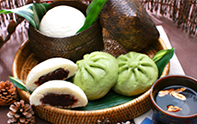
Check out more Korean food features on Visit Korea!
K-Culture: “Surasang” – The 12-Dish Table Spread Served For The Joseon Royalty
Source: Visit Korea
[wpedon id=”2271″ align=”center”]

